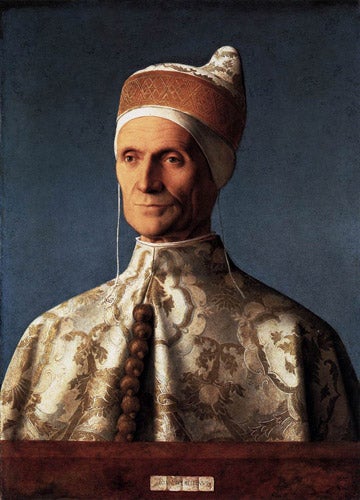Great Works: Doge Leonardo Loredan (1501-2), Giovanni Bellini
National Gallery, London

He utterly dominates Room 62 of the Sainsbury Wing of the National Gallery, this steely-eyed man, just as he would once have dominated the intricately vicious politics of Venice at the turn of the 16th century. I am speaking of Doge Leonardo Loredan, as depicted by Giovanni Bellini, in a painting said to have been executed in about 1501, the year that the Doge took office, an office he was to hold, unbroken, for the next 20 years of almost ceaseless warfare between the Republic and her many enemies. To call this portrait arrestingly magnificent is to sell it short. It is one of the greatest and most startling portraits of the Western canon, painted by a man, the greatest painter of an entire family of remarkable painters, who was at the heart of the political and cultural life of Venice for the duration of his long life – Giovanni Bellini finally died in 1516, aged 86.
I have a crude rule for testing the worth of any work of art. It is called the ten-second test. If any work of art is worth staring at for as long as 10 seconds, it stands a chance. That's it. Most works of art – and especially those which are being made today under the name of "art" – fail that test miserably. Three seconds, perhaps four, are quite enough. To apply such a test to this portrait of the Doge would be laughable in the extreme. The more you stare at it, the more you become absorbed into the marvellously unsettling richness of its ambiguities. There is the test, you see: this work is inexhaustible. The more you look at it, the more it seems to say to you. In this respect, it resembles a great poem.
Surprisingly for a secular portrait, the Doge is not in profile, but face-on (well, in fact, just slightly askance) to the painter and the onlooker – this face-on mode of depiction, for most of the Middle Ages, was generally reserved for sacred portraiture. Now a Doge, a mere mortal man, has been given the treatment once reserved for sacred subjects. And yet this man was not a king, and even less an absolute monarch – and we sense and feel this from the way in which Bellini has painted him. Monarchs more often than not look like over-stuffed balloons. They have little characterful reality, little genuine solidity. They are little more than the majestic way in which they are being represented. Think of Van Dyck's ridiculous portrait of Charles I on horseback, for example, recently on display at Tate Britain, coming towards us like a bewigged crazy on a pantomime horse, or of Goya's glittering dismissals of the Spanish Royal Family whose court painter he was paid to be. More fools them! These paintings, for all their visual splendour, are often nothing but gloriously laughable pieces of puffery. They are lies.
The Doge, on the other hand is at least two things at once. He is a human being spectacularly adorned in the vestments of his office – gorgeously brocaded mantle worked over, in gold thread, with pineapple motifs which we can see upside down; a ducal cap – known as a "corno" (an allusion to its single horn) – worn over a linen skullcap – but he is also the brutally focused man that he needed to be in order to negotiate his way through the diplomatic challenges of being Doge of the Republic of Venice. This face is lean, wary, ascetic, almost to the point of revealing a slight tendency towards emacation. A spiritual man then – but a spiritual man with an iron fist. It is the face of a master tactician, a diplomat. This is not a fat-faced Henry.
We are also a little surprised by the fact that the portrait is relatively modest in size – portraits of men of importance are usually as large as possible. This reminds us of the fact that the Doge was a man among men, elected by a committee of 41 aristocrats, perpetually subject to checks and balances, and a man, moreover, who earned relatively little from his official duties; who was not allowed to show favours to members of his own family, and whose rights to own properties outside the Republic was severely restricted. And yet his ceremonial functions were extraordinary – and this is why he is tricked out in such splendour, in robes of such brilliance.
But he ends mid-chest, and he stands behind a marble balustrade, looking out towards the Grand Canal or the Piazza San Marco (or, since the middle of the 19th century, towards rivals for his attention at London's National Gallery), coolly appraising, almost rigid. Why is he cut off like this? Why is he not full-length? (By all accounts, he was not a short man so, unlike, say, Alan Ladd, he did not need to pretend.) Again, it is all to do with politics. The head-and-torso format of this portrait reminds us – and, I am sure, quite deliberately so - of Roman portrait busts. One great empire leads naturally on to another. It is also an attested fact that the Doge's family believed itself to be the direct descendants of a Roman hero called Gaius Mucius Scaevola.
I too am a hero, he is telling us, a servant of god, a master among men, within strictly defined limits, of course, which I not-so-humbly acknowledge.
Subscribe to Independent Premium to bookmark this article
Want to bookmark your favourite articles and stories to read or reference later? Start your Independent Premium subscription today.

Join our commenting forum
Join thought-provoking conversations, follow other Independent readers and see their replies